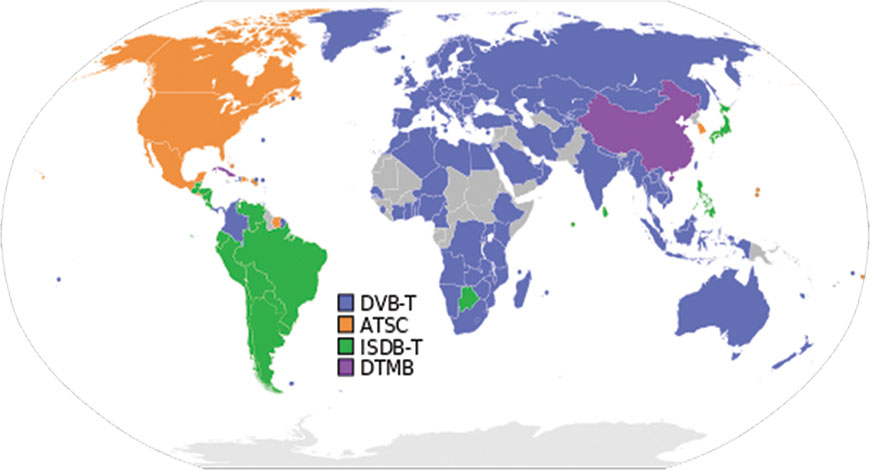Antenna
Making the digital media transformation

Over just a few years, the world of television production, distribution, and consumption has changed dramatically. In the past, with only a few channels to choose from, viewers watched news and entertainment television at specific times of the day or night. They were also limited by where and how to watch. Thanks to the rise of the internet – and, in particular, mobile technology – people have nearly limitless options for their news and entertainment sources. Not only that, they can also choose to get news and other media on TV or on a variety of smart devices, including phones, tablets, smart watches, and more. The TV industry too has now been moving to the high definition from the standard definition, and the discussion is about 4K and 8K video standard.
After years of radical fluctuation, the media and entertainment market is finally reaching a more stable pattern. It is no longer a question of digital transformation will happen; the question is how companies will respond. Leveraging the opportunities presented by digital video, new players are entering the market, capturing consumers’ imaginations – and their wallets.
Across the content value chain, aggressive commercial bets are being placed on new business models, acquisitions, partnerships and services. The window of opportunity for the leading players to secure their position is narrowing and decisions need to be made rapidly. To compete in this new ecosystem, new digital-based business strategies and associated capabilities are essential. Companies that hesitate now may spend years trying to catch up.
Video Businesses
Few other industries have seen the barriers to entry fall so rapidly and witnessed the emergence of so many highly disruptive threats as the communications industry. Today each business is part of a complex ecosystem involving multiple players including web-based content distributors (e.g., Netflix), superplatforms (e.g., Google), communication service providers (e.g., Bharti Airtel), device manufacturers (e.g., Apple, Samsung), traditional content distributors (e.g., FTA broadcasters and pay TV), retailers (e.g. Amazon), rights owners, software development community (e.g., mobile and other connected apps), and gaming platforms (e.g., Xbox, PS4).
Thriving in this highly complex and evolving eco-system requires traditional video businesses to determine the assets, capabilities, and skills to add or develop in order to be relevant in the new digital market place.
Broadcasters, Telcos, and Cable Companies
The speed and magnitude of disruptive change that digital video is generating is resulting in the need for broadcasters, telcos and cable companies to evolve their business models rapidly and at scale. To successfully compete in the new ecosystem, each one is moving from a silo-based architecture and process landscape to a horizontal approach supported by common services and infrastructure that helps to balance costs with revenues. In these times where content costs continue to increase, the benefits of implementing lean operations, leveraging customer feedback continuously in service creation, and being prepared to experiment with new business models, can all pay dividends. Collecting data and leveraging analytics empowers organizations to build B2C relationships across all digital channels.
A clear engagement strategy, aligned with traditional content functions requires to benefit from this data, which can in turn support more sophisticated segmentation, price optimization and targeted advertising and even increase the success of content commissioning. As IT becomes more pervasive across core business processes than ever before there are clear benefits of positioning. IT can take charge of the digital journey. Adapting to a fast-changing world by embracing the use of developers with stronger system integration skills, automated testing, continuous development, and management teams accustomed to making data-driven decisions, can reduce operational risk and increase speed to market. In a hybrid world where legacy video services coexist with IP-based video services, companies must operate with broadcast availability and broadband flexibility. To optimize costs with decreasing revenues, legacy video platforms should be operated and transformed whilst constantly looking for ways to decrease TCO – which is a challenge as the proliferation of IP-based video services at scale actually makes operations more complex.
Cable Operators
The cable operators have enjoyed a relatively favorable position for years, thanks to superior technology, a stable video ecosystem, and favorable regulatory conditions. Their infrastructure has enabled them to offer customers very high bandwidth compared to traditional operators that relied on a DSL line that, in the best cases, could offer bandwidth in the region of 10–15 Mbps. Cable operators, able to scale up to 100Mbps or more, were also able to serve multiple TV screens in the household as a result of the broadband infrastructure that they built.
However, the same infrastructure that provided competitive advantage is now also creating a challenge for cable companies. Their video on demand (VoD) and linear content architectures were built some 10 years ago, and set-top boxes are now aging. Cable operators face major competition now that traditional operators are starting to roll out fast fiber to the home. In response, cable companies have been evolving their legacy platforms to an Internet protocol (IP)-based infrastructure or hybrid QAM and IP. To achieve that, they are gradually reducing the spectrum on their cable dedicated to broadcast and moving more towards IP traffic, in the process reducing the spectrum available to linear channels. This implies gradual adoption of an IP-based framework on the back end of the network in order to compete by delivering interactive services – an area in which cable operators have historically been slow to innovate. To succeed in both IP and linear worlds, cable operators need to take control of the evolution of the set-top box. Emerging standards such as the reference design kit (RDK), offer an integration layer for cable operators to build their own set-top box interfaces. Doing so will make it possible for them to achieve the flexibility they need to tune the right blend of services that they offer between broadcast and interactive IP-based services.
TV Stations
Television stations that embrace new technology, digital media, storage, cloud computing and sharing will see massive improvements in social value. This transformation enables the station to produce timely and accurate reports faster, giving the audience the freshest information and entertainment. Technologies like cloud-based high-definition video production and cloud-based storage and sharing architectures eliminate many of the challenges and pain points associated with reporting news and bringing TV entertainment to a large audience.
An all-IP based video injection process is a must if TV stations want to lower network complexity and simplify system maintenance. Another major factor in any digital media transformation is big data and data analytics. Through these and other information and communication technologies, such as the Internet of Things (IoT), SDN (software-defined networking), improved mobile broadband, etc., television stations can bring faster, more accurate, and more convenient news and entertainment to their customers and viewers.
The Role of Standards
To keep pace, broadcast TV migrated to digital signals over the past 20 years, representing the first major technology shift since analog color TV was introduced in the 1950s. Digital broadcast TV offers improved, high-definition pictures, more realistic sound, more channels, and more choices.
But changes in media, how it is accessed and consumed, and consumer behavior continued to evolve at an increasingly rapid rate. Consumers, quick to adopt new media and ways to tap into it, have come to expect the ability to access sight-and-sound content from any source on any device, anywhere, anytime – whether that content is broadcast over-the-air, delivered via cable, satellite, phone lines or stored at home.
Digital TV was a start in this direction, but the past dozen years have witnessed technology revolutions in nearly every related field and consumer expectations have risen accordingly. Alternative delivery paths have proliferated. Receiving devices such as smartphones and tablets have proliferated. Consumers expect interactivity. Behind the scenes, major improvements have taken place in video and audio coding efficiency, while broadcast spectrum has become scarcer.
Invisible to consumers are the technical standards that enable solutions to broadcast TV’s challenges. Standards really provide the basis for fundamental shifts in technology because they ensure the interoperability and economies of scale that lead to innovation and market adoption.
In USA, very recently, in March 2018, broadcasters got a green light from the FCC to begin rolling out a new over-the-air TV standard. The update to the improved ATSC 3.0 standard gives broadcasters a chance to compete in an increasingly crowded market. This is the first major upgrade in broadcast TV since the transition to digital signals (DTV) in 2009.
Next Gen TV is an internet protocol (IP) based system, which means it can carry internet content alongside the traditional over-the-air broadcast signal. The newer standard supports 4K video and high dynamic range content. This opens up never before available interactive features like video-on-demand and advanced emergency alerts for broadcast TV.
Marketers hope that the new standard will drive sales of 4K TVs that can deliver the ultra-high definition picture quality. Cord cutters eager to have access to the enhanced picture and audio might line up to buy new TVs enabled with the technology, but neither the technology nor the TVs are likely to be ready before 2019. The best news is that Next Gen TV signals will be stronger and will transmit over greater distances and deeper into buildings; not only will broadcast TV be better, but the reception will be as well. The technology is considered a game changer because it is the first time that a broadcast format has the advantages of broadband.
However, just because the US is transitioning to ATSC 3.0 slowly, does not mean all countries are. LG is including both dual receivers in newly manufactured TVs shipping to South Korea, as the country has already implemented Next Gen TV as the national broadcast standard. In fact, the PyeongChang 2018 Olympic Winter Games were broadcast entirely in the new standard there.

DVB-T, the Digital Video Broadcast-Terrestrial system is the other standard used in most of the rest of the world. DVB-T was designed for format compatibility with existing direct broadcast satellite services in Europe (which use the DVB-S standard, and also sees some use in direct-to-home satellite dish providers in North America), and there is also a DVB-C version for cable television. While the ATSC standard also includes support for satellite and cable television systems, operators of those systems have chosen other technologies (principally DVB-S or proprietary systems for satellite and 256QAM replacing VSB for cable). Japan uses a third system, closely related to DVB-T, called ISDB-T, which is compatible with Brazil’s SBTVD. The People’s Republic of China has developed a fourth system, named DMB-T/H.
In 2018, after many years of dedicated work, participants in the standards development process will finally see the fruits of their labors in setting a 21st century course for the evolution of broadcast TV that will revitalize the industry and bring consumers a plethora of delightful, sensory-rich benefits.
With the marriage of broadcast and broadband, consumers will finally realize their evolving demand for access to content from any source on any device, anywhere, all with immersive audio, high-definition video, added services (including improvements in public emergency notifications) and interactivity.





You must be logged in to post a comment Login